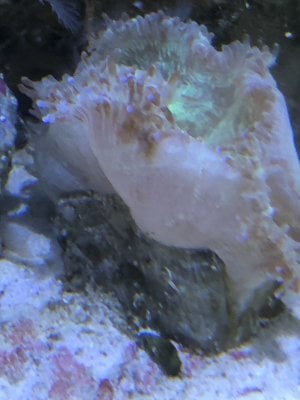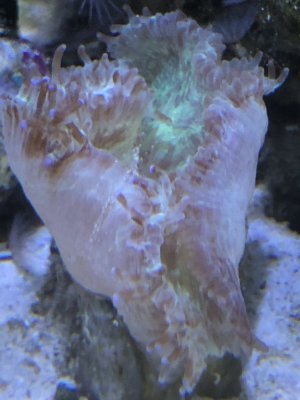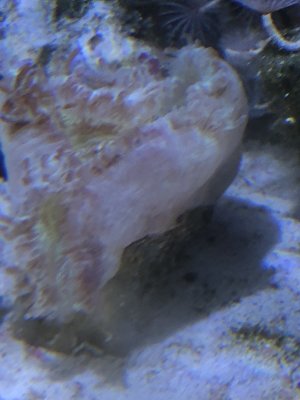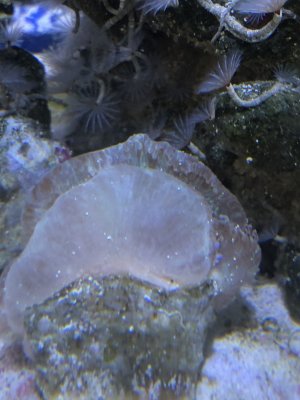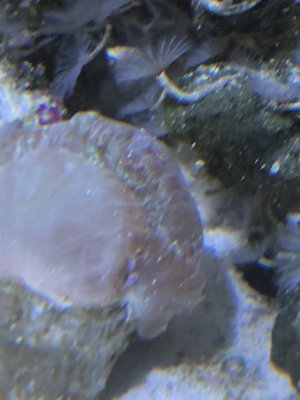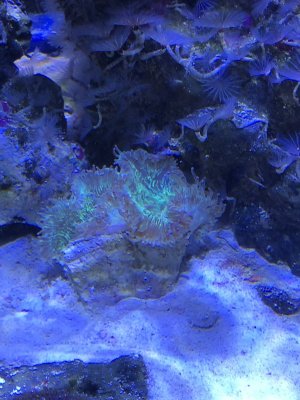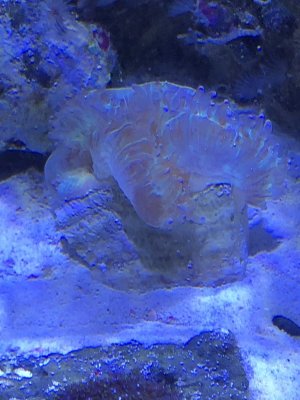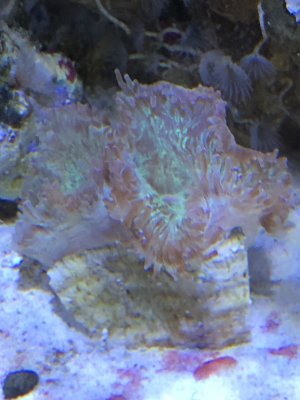It was almost 20 years ago I first introduced the Fresh Water Dipped (FWD) protocol for treatment of Pinched Mantle Disease (PMD). Over the years, many reefers altered the protocol somewhat but, on the whole, it still is the only tried and true way to treat PMD, a universally fatal disease if untreated. Lately, I began using this protocol on a different disease, the Elegance Coral Syndrome (ECS). Early indications are that this can be effective in treating this disease also. I will discuss more on this later.
I am a Physician with formal training on research and developing treatment protocols for various diseases. I am also an avid aquarist. I have been keeping fresh water aquarium since I was a child. In addition, I started my first marine aquarium in 1980 and reef aquarium in 1996. I also got hooked on clams in 1996. Those days, one can only get blue Maxima from the Red Sea, and they were expensive. In 1997, I ordered several Crocea, Maxima and Squamosa clams from Dick Perrin at Tropicorium in Romulus, Michigan. This shipment was delayed by UPS for 1 day. When the shipment did not arrive, I called Dick to check the status of the order. He reassured me that the clams would be fine. Dick said the clams were healthy and he packed them well. He also said the clams were hardy enough to tolerate the delay. As example of how hardy clams are, Dick mentioned that he once forgot a tray of Maxima clams for several hours in fresh water. The clams tolerated the mishap fine, none of them died. On further discussion, Dick said all his newly imported clams received a fresh water dip for disease control. This planted the seed of using fresh water dip as a possible treatment for clams in my head. Dick was right about the clam shipment. All my clams arrived in good condition. Enclosed are some pictures of the clams I got from Dick Perrin back in 1997. These pictures are of poor quality because digital cameras at the time were expensive and of very low resolution. Even with these poor resolution pictures, we all can see that these clams are healthy and very colorful. These were the Ultra Maxima and Crocea back then. I am not sure why but these Ultra Crocea are not available very often today. I also ordered some corals and clams from Jeff's Exotic Fish. Anybody remember this MO business from LA?
This was a Red Sea Maxima, the most expensive clam I got back then, I got from Dick Perrin of Tropicorium
Two really beautiful Crocea's, I also got from Dick Perrin of Tropicorium
A Blue Maxima
Squamosa, a Dead Crocea and part of a Derasa
Another Blue Maxima
First Grade Blue Maxima
Fast forward to early days of the 21st century, I was a full blown clam fanatic. I kept a 420 gal reef system at the time with numerous Tridacna clams of all five species. It was nice enough that it was featured in the Inaugural issue of Advance Aquarist, and online Aquarium magazine, in January, 2002. At the time, my clams started to contract PMD from newly imported clams. In this Aquarium of the Month write up for Advance Aquarist, some of the pictures showed that several of my clams were infected with early PMD. These pictures are attached below.
4 of the 5 know species of Tridacna, at the time, were represented here. Some of these clams are clearly recently afflicted with PMD. The Squamosa in this picture had huge white growth shell, but far advance with PMD. Almost 1/2 of the mantle in one side was retracted. The two Ultra Blue and the Black and White Maxima were also afflicted. The Green Crocea was affected but not clearly seen here.
In this picture, the Gigas just started to get affected as was the Ultra Turquoise Crocea.
Close up of my pride and joy that are fairly advance in the course of the disease.
As you all can see, in 2001 I was up to my eyeballs with Pinched Mantle Disease.
PMD is only one of the various causes of clam mantle retraction. I struggled with this so much that I can clearly remember the disease and can still even visualized the image of some of my clams. I even remember the Derasa that brought this disease to my tank. A friend here in Corpus Christi, had a new Derasa that was not doing well. My clams were growing like gang busters. I was cocky, and was sure that I can get him back to health and offer to “nurse him back to health for my friend”. That was the source of my heartaches and headaches for the next several years.
I struggled with this disease for several years. These were my observation of Pinched Mantle Disease:
- The previously healthy clam, newly infected will appears healthy but will have retraction of one area of the mantle. This was not true with clam that was send to me sick, but always true with clams that were healthy then infected in my tank.
- The irritated, diseased mantle always retracted at the same place and mantle retraction spread from there.
- This disease affected all five species of Tridacna in my tank.
- The disease was slow in onset and healthy clams can live for months with this disease. My large Gigas live for over 1 year with the disease until I cure him with FWD
- Clam mantle retraction spread slowly from one area to adjacent area, rarely skipped area of mantles.
- Disease spread from adjacent clams most easy but there are infections of clams at distance location. This is much more common when the numbers of clams that were infected in a tank increased.
- Clams look better in AM, but mantles become much more irritated, more contracted by the end of the photoperiod.
- As the days go on clams secrete strands of mucus that can be seen extended from the disease mantles
- As the disease progress, the mantle retractions worsens and more, the diseased clam dies of starvation.
“Pinched Mantle Syndrome is a term used by marine reef hobbyists to describe a disease condition in the ornamental clam Tridacna crocea and Tridacna maxima. The disease causes localized mantle retraction, gaping, loss of coloration and, eventually, mortality. A Perkinsus olseni-like protozoan has been identified as a possible cause of the disease. Based on this preliminary work, histopathology is the preferred method to confirm the presence of the parasite within the tissue of Tridacna crocea.”
I just wanted to say that this does not describe the same disease. The authors were looking for pathogen within the tissue of the clams. Disease within the tissue will never response to a fresh water dip. Because of this reason, it is likely that the parasite within the tissue of some of the clams by these authors were not true pathogen for PMD (as described and effectively treated with FWD)
I struggled with PMD for almost 2 years. All of my observation and treatments predated the above article published in 2009. It devastated my clams. There was a lack of available research and reading material on the subject. I soon quickly realized that this was a completely new disease, un-described by science or hobbyists. Participation in online discussion with other clam keepers did not result in any more insight as to how to deal with this disease. If any of us still remember this time, this disease devastated the clam market. It is a communicable disease, likely transmitted at the wholesale level, so in the early and middle part of the 2000 decade, a lot, if not most of newly imported clams were infected with PMD by the time it get to our aquariums. From observation of my sick clams, how PMD spread to other clams by proximity, and how gradual, progressive of the irritation to the mantles, I came to a conclusion that PMD is caused by infection. By observing the progress of the disease, how the mantle reacts, and irritated, and the mucus that it produced, I guessed and hoped that it is a surface infection. Remember how Dick Perrin told me that he used FWD to control diseases? I tried this treatment on some of the clams with PMD and found that it was very effective. Multiple trials of treatments were initiated. I worked work out the length of the FWD, and the need to transfer them to a new environment so they cannot get re-infected.
That was how I came up with using FWD to treat PMD. After I was able to cure PMD in my own tank, I was in a position to help a numbers of reefers on line via online discussion boards. Three of them in particular, ReefCentral, Reefs.org and The Reef Tank were the largest 3 boards at the time. Some of you may remember these discussions. My online name was Minh Nguyen at the time instead of OrionN as it is today.
I cannot stress enough that there are many different causes for retraction of clam mantles. Anything irritated the clams will cause them to retract their mantles. PMD is only one of these conditions.
FWD for 30 minutes and transfer to a new tank, free of PMD, is effective in the treatment for PMD. I do have a word of caution regarding using FWD to treat PMD in clams. This treatment will only work if the disease is diagnosed correctly and the clam is still strong enough to tolerate treatment. PMD kills slowly. The parasite load increase, and cover more of the mantel causing irritation to the mantel of the clam resulting in contraction, thus starving of the clam. Anything that irritates the mantle will result in retraction. Therefore, just because the mantle is retracted it does not automatically mean that the clam has PMD. FWD is still the only treatment for PMD in clam that is effective. Enclosed are pictures of a Derasa of a friend, Outerbank, with PMD. He treated this clams with a 30 minute FWD as per my recommendation and was able to cure it.
These pictures was taken within the last month. Outerbank's Derasa sicken with PMD pre-treatment
Another picture of the same clam
Here he is a few days post treatment. Outerbank reported that the Derasa completely recovered at this time.
Picture this PM send to me by Outerbank
I have been thinking about another disease. Most of us know that Elegance Corals sometime get sick with Elegance Coral Syndrome (ECS). This disease is very similar to PMD of clams in that the coral initially retractes on part of the oral plate and tentacles. This worsens with light exposure, and gets worst later in the day. The coral produces copious mucus. The retraction slowly spreads and the coral usually ends up fully retracted until it melts away leaving the skeleton. As far as I know, there is no treatment, and it is also a communicable disease. Introduce one sick Elegance Coral to a tank with healthy specimen will invariably result in death of both. I have been thinking about this treatment but I haven’t been able to experiment with it until a few weeks ago. One of my friends, Alton, bought an Elegance coral that ended up with ECS. As a last ditch effort to keep this coral alive, I recommended FWD. Alton’s Elegance did great and is on its way to recovered fully.
Pre treatment picture of Alton's Elegance Coral with ECS
Post treatment of the same coral, on it's way to recovery.
Why does FWD work? Fresh water is toxic to marine animal. If we put living tissue that normally lives in sea water into fresh water, the osmotic changes will result in the cell absorbing water, swelling up and rupture. Animals with exoskeleton likely tolerate this a little better than soft body animals. Also the larger the animal, the longer they can tolerate fresh water dips. This is due to the fact that larger animals have a smaller surface to volume ratio than smaller animals. This is why parasites, smaller animals (maybe single cell organism) normally die much quicker in fresh water immersion than the clam. Also the parasite must be on the surface of the infected animal. If the parasite is inside the tissue of the infected animal, the parasite will not be exposed to the fresh water, thus treatment will be ineffective. IMO, in PMD and ECS, the pathogens are small, maybe unicellular organisms, which lived on the surface of the host. Dipping the host animals in fresh water will result in rupture of the pathogens. If we remove the host animals from fresh water before they become irreversibly damage, they will recover and live on free of the pathogen.
I hope this write up will help some of the animals that we keep in our tanks. Elegance corals are smaller than clams and their tissue are thinner over the skeleton. I advised Alton to dip his sick Elegance coral for 15 minutes while the protocol for treatment of PMD in clams is well known, FWD of 30 minutes. Second treatment is rarely needed.
We have always known that FWD can be used on with fish for external and for gill parasites, used of LPS and SPS for various parasites like flatworms. To treat flat worms on corals, SPS and LPS, swirl the coral in fresh water for several minutes, and blow the flat worms off of the corals. I have treated Euphyllia, Gonipora, and Alveopora with fresh water dip to remove parasitic flat worms from the coral successfully before. If the infestation is on the surface, and the coral or fish can tolerate fresh water for some duration of time, we can use it to kill, or at least disable the parasites and they will fall off of the hosts. If the host, invertebrates or fish, can survives the treatment, we can cure them of the disease by remove all the parasites with FWD.
Happy reefing everybody.
Last edited:




